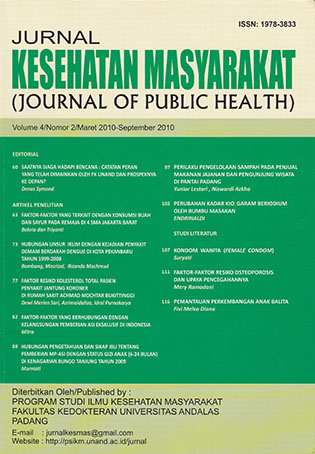Abstrak
Di Amerika Latin dan negara-negara berkembang kira-kira 1 5-30% anak usia kurang dari 4 tahun mengalami gizi buruk berdasarkan data tahun 2005. Di Indonesia berdasarkan data Susenas 2005 prevalensi terendah masalah gizi buruk dan gizi kurang adalah Yogyakarta (15,1%) dan tertinggi Gorontalo (46,11 %). Di Sumatera Barat prevalensi gizi kurang dan gizi buruk yaitu (30,4%). Hasilpemantauan status gizi (PSG) kota Padang tahun 2007 menunjukkan bahwa di Padang 2,2% balita dengan gizi buruk. Tujuan dari penulisan studi literatur ini adalah untuk mengetahui perkembangan anak, ciri-ciri perkembangan anak, prinsip perkembangan anak, faktor-faktor perkembangan anak dan bagaimana cara memonitor perkembangan anak. KPSP (Kuesioner Pra Skrining Perkembangan ) merupakan suatu instrumen deteksi dini dalam perkembangan anak.
Authors who publish with this journal agree to the following terms:
- Authors retain copyright and grant the Andalas Journal of Public Health right of first publication with the work simultaneously licensed under a Creative Commons Attribution License (CC BY-SA 4.0) that allows others to share (copy and redistribute the material in any medium or format) and adapt (remix, transform, and build upon the material) the work for any purpose, even commercially with an acknowledgement of the work's authorship and initial publication in Andalas Journal of Public Health.
- Authors are able to enter into separate, additional contractual arrangements for the non-exclusive distribution of the journal's published version of the work (e.g., post it to an institutional repository or publish it in a book), with an acknowledgement of its initial publication in Andalas Journal of Public Health.
- Authors are permitted and encouraged to post their work online (e.g., in institutional repositories or on their website) prior to and during the submission process, as it can lead to productive exchanges, as well as earlier and greater citation of published work (See The Effect of Open Access).

